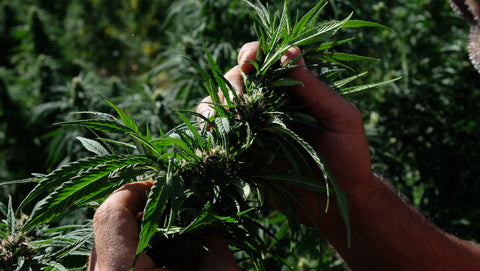Experienced growers know this: marijuana is a plant with copious yields, with very high resistance to stress and moderate needs. However, it is not certain that every cannabis cultivation yields the same yield in terms of yield.
To ensure that harvests are always abundant, professional growers have invented many techniques designed to increase production yields.
These are often aggressive pruning methods that push the plant to develop more and take on a shape and size different from its natural ones.
Other techniques instead require the plant to be subjected to strong stress , which, by putting the entire organism on alert, pushes it to develop more and faster. Here's what we'll talk about:
- Supercropping: what is it?
- We die a little in order to live
- When to start supercropping
- How to supercrop
- Supercropping: pros and cons
Supercropping: what is it?
Supercropping – or High Stress Training – is a method designed to increase the productive yields of cannabis and consists of bending – until breaking – one or more branches of a plant , to stimulate it to rebuild the damaged parts, which will be stronger and more resistant .
It is therefore a technique that allows you to control the shape of the plant and at the same time increase its yield.
Plants treated with supercropping take on the typical canopy structure , due to the bent branches that point downwards; in this way, the apical parts of the plant receive light in a much more uniform way.
By improving exposure, the plant is stimulated to develop more compact and larger flowers, even in areas normally occupied only by leaves.
It is therefore a technique that focuses entirely on light distribution , one of the most important factors to keep under control when growing cannabis, especially indoors.
When a Cannabis plant begins to flower, the size of its buds will also depend on the light exposure it receives. The areas most exposed to light will produce much larger and more powerful buds than the lower and more hidden ones.
With supercropping a large part of the plant will be exposed to light in the same way , with the result that the plant develops much more uniformly than normal.
“We die a little in order to live”
As Battiato sang in one of his famous songs, "you die a little in order to live".
This is exactly what happens to supercropped plants: they undergo very significant stress following branch breakage , but then they recover and grow stronger than before.
The technique involves bending the branches of the plant until the pith contained within them is broken, just below the beginning of the floral cluster. If done right, the top will only expose one side to light.
At first glance the inflorescence, which was previously lush and healthy, will seem seriously damaged, but recovery times should be very short, usually everything returns to its place in one night.
The principle of supercropping is to expose the bud along its entire length to light , so that the entire sequence of calyxes will receive more light during the flowering cycle, rather than being shaded by neighbors on the upper branches.
More light means more growth and, consequently, more flowers and resin.
Super Cropping should always be done when plants begin to differentiate. In this way the new flowers on the lower parts of the branches will have the same opportunity to receive the right light from the beginning.
You need to do it several times on the same spot on the same floral cluster, making sure the top is folded horizontally.
When to start supercropping?
The right time for cropping is given more by the size than by the age of the plant : growers recommend starting when the plant is at least 40 cm tall .
At that point it is ready to be cropped. In any case, it is recommended to carry it out starting from the third week of the vegetative phase until the second week of the flowering phase .
Each cannabis plant has a different stress tolerance and structural resistance. Some varieties can be very woody and fragile and, as a result, can break very easily.
Others, however, are more resistant and elastic to bend, without suffering significant damage. By softening the internal and external fibers, the branch becomes more flexible and easier to bend.
It is important to pay close attention and perform the technique correctly, otherwise you will only end up breaking a branch.
How is supercropping done?
Supercropping is a procedure for brave growers. If you are faint of heart we advise you to think about another way to increase the yields of your plants.
To crop the branches you need to act decisively, but without crushing them, exerting firm and constant pressure on the stem.
If you are continuing to read it means that you feel you can do it. So how do you perform perfect supercropping?
Once you have selected the various parts of the plant on which to apply Super Cropping, you can proceed with the actual bending.
Hold the branch still between thumb and forefinger and apply light pressure until the internal cord breaks , keeping the external tissue intact.
There are several ways to do this: you can move the portion of the branch back and forth until you feel a slight crack; you can slowly bend the branches back and forth to direct them and obtain the desired canopy shape; you can simply break the portion of the branch that you consider most suitable for forming a canopy structure.
You probably won't like the sight before your eyes. Your plant almost looks like a weeping willow, most of the branches hang downwards and it will seem like you have deliberately destroyed your cultivation.
Don't panic, it's not over yet!
The next step is the construction of the famous canopy shape . You need to tie the broken ropes in the new position, so that they continue to go downwards.
The best solution is to use some plant ties, which guarantee good anchoring to the ground. It is important to tie the branch below the split and not from the top , to prevent the plant from becoming further tired.
Those who have already done some supercropping often don't even tie the branches downwards, because they know exactly where to bend. It's a matter of experience, it will come even for beginners!
As already mentioned, care must be taken during the folding phase. Excessive pressure could break the branch cleanly and cause you to lose the already born inflorescence.
Cannabis is a strong plant and almost always recovers, but you can never be too careful.
Good advice is to always start with the lateral branches , and never with the main stem, since at first experience the results may not be those hoped for.
If a branch or the main stem breaks during execution, all is not lost!
Always keep a roll of adhesive tape handy, with which you will wrap the wound, trying to make the two ends adhere again. Cannabis plants are very resistant and after about 10-14 days the wound should be perfectly healed and you can remove the tape.
Supercropping: pros and cons
IT IS CHEAP
Supercropping is a technique that allows you to influence the shape of plants to maximize their productive yields , without the need to use particular tools or skills, except for a clear mind and a steady hand.
GREATER AND POWERFUL HARVESTS
Plants subjected to Supercropping also tend to become more potent , since resin production is greatly influenced by external stresses . It is recommended for growers with limited space.
IT CANNOT BE USED WITH AUTOFLOWERING
Growers of autoflowering strains should avoid supercropping , as autoflowering cannabis responds negatively to this type of stress.
Since it affects the vegetative period of the plant, which will need longer times to recover from stress, it can only be applied to photoperiodic varieties with 6-8 weeks of vegetative growth.
For autoflowering varieties, it is recommended to perform another technique similar to cropping, called LST - Low Stress Training , which allows the plants to grow low, compact and with all the flowers well exposed to the light, thus obtaining an ideal condition for indoor cultivation.
The forced lowering of the main bud causes the plant to move the growth hormones, auxins, to the secondary buds, thus obtaining many flowering points of the same size .
To do this, the stem and branches are delicately bent, fixing them in order to control the shape of the plant during growth and flowering. It is an ancient technique and used for many types of plants.
IT IS NOT RECOMMENDED FOR LARGE CROPS
In large marijuana plantations, Supercropping may require too many hours of hard work. To obtain similar results, without breaking hundreds of branches by hand, you can use the Scrog technique .
Scrog consists of growing the main stem of the plant horizontally while the buds and tops grow vertically with the help of a support.
Usually a 5 cm mesh net is used which is placed 20/30 cm from the pot, the plant and the main branches will therefore grow horizontally fixed to this net, while the buds following gravity will develop vertically giving rise to an expanse of dense, low and above all very large buds.
The objective is always better management of light, which will thus only be received by the buds or buds that can develop the full potential of the plant.
If the article was of interest to you, share it on social media with the rest of the Community, every single share helps us support our blog and keep you 360° informed on the world of Cannabis.
You might also be interested in:









